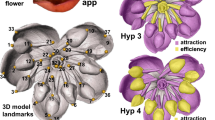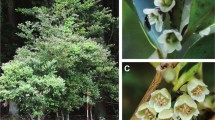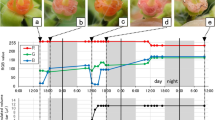Abstract
We all appreciate the fantastic diversity of flowers. How flowers diversified, however, remains largely enigmatic. The mechanisms underlying the diversification of flowers are complex because the overall appearance of a flower is determined by many factors, such as the shape and size of its receptacle, and the arrangement, number, type, shape and colour of floral organs. Modifications of the developmental trajectories of a flower and its components, therefore, can lead to the generation of new floral types. In this Review, by summarizing the recent progress in studying the initiation, identity determination, morphogenesis and maturation of floral organs, we present our current understanding of the mechanisms underlying the diversification of flowers.
This is a preview of subscription content, access via your institution
Access options
Access Nature and 54 other Nature Portfolio journals
Get Nature+, our best-value online-access subscription
$29.99 / 30 days
cancel any time
Subscribe to this journal
Receive 12 digital issues and online access to articles
$119.00 per year
only $9.92 per issue
Buy this article
- Purchase on Springer Link
- Instant access to full article PDF
Prices may be subject to local taxes which are calculated during checkout

Similar content being viewed by others
References
Chandler, J. W. Founder cell specification. Trends Plant Sci. 16, 607–613 (2011).
Chandler, J. W., Jacobs, B., Cole, M., Comelli, P. & Werr, W. DORNRÖSCHEN-LIKE expression marks Arabidopsis floral organ founder cells and precedes auxin response maxima. Plant Mol. Biol. 76, 171–185 (2011).
Cheng, Y., Dai, X. & Zhao, Y. Auxin biosynthesis by the YUCCA flavin monooxygenases controls the formation of floral organs and vascular tissues in Arabidopsis. Genes Dev. 20, 1790–1799 (2006).
Okada, K., Ueda, J., Komaki, M. K., Bell, C. J. & Shimura, Y. Requirement of the auxin polar transport system in early stages of Arabidopsis floral bud formation. Plant Cell 3, 677–684 (1991).
Besnard, F. et al. Cytokinin signalling inhibitory fields provide robustness to phyllotaxis. Nature 505, 417–421 (2014).
Chandler, J. W. & Werr, W. DORNRÖSCHEN, DORNRÖSCHEN-LIKE, and PUCHI redundantly control floral meristem identity and organ initiation in Arabidopsis. J. Exp. Bot. 68, 3457–3472 (2017).
Aida, M., Ishida, T., Fukaki, H., Fujisawa, H. & Tasaka, M. Genes involved in organ separation in Arabidopsis: an analysis of the cup-shaped cotyledon mutant. Plant Cell 9, 841–857 (1997).
Sieber, P., Wellmer, F., Gheyselinck, J., Riechmann, J. L. & Meyerowitz, E. M. Redundancy and specialization among plant microRNAs: role of the MIR164 family in developmental robustness. Development 134, 1051–1060 (2007).
Wang, P. P. et al. Flexibility in the structure of spiral flowers and its underlying mechanisms. Nat. Plants 2, 15188 (2016).
Becker, A. Tinkering with transcription factor networks for developmental robustness of Ranunculales flowers. Ann. Bot. 117, 845–858 (2016).
Damerval, C. & Nadot, S. Evolution of perianth and stamen characteristics with respect to floral symmetry in Ranunculales. Ann. Bot. 100, 631–640 (2007).
Causier, B. & Davies, B. Flower development in the asterid lineage. Methods Mol. Biol. 1110, 35–55 (2014).
Hirano, H.-Y., Tanaka, W. & Toriba, T. Grass flower development. Methods Mol. Biol. 1110, 57–84 (2014).
Prunet, N. & Jack, T. Flower development in Arabidopsis: there is more to it than learning your ABCs. Methods Mol. Biol. 1110, 3–34 (2014).
Schnablová, R., Herben, T. & Klimešová, J. Shoot apical meristem and plant body organization: a cross-species comparative study. Ann. Bot. 120, 833–843 (2017).
Laux, T., Mayer, K. F. X., Berger, J. & Jürgens, G. The WUSCHEL gene is required for shoot and floral meristem integrity in Arabidopsis. Development 122, 87–96 (1996).
Schoof, H. et al. The stem cell population of Arabidopsis shoot meristems is maintained by a regulatory loop between the CLAVATA and WUSCHEL genes. Cell 100, 635–644 (2000).
Sun, B. & Ito, T. Regulation of floral stem cell termination in Arabidopsis. Front. Plant Sci. 6, 17 (2015).
Coen, E. S. & Meyerowitz, E. M. The war of the whorls: genetic interactions controlling flower development. Nature 353, 31–37 (1991).
Morel, P. et al. Divergence of the floral A-function between an asterid and a rosid species. Plant Cell 29, 1605–1621 (2017).
Wu, F. et al. The ABCs of flower development: mutational analysis of AP1/FUL-like genes in rice provides evidence for a homeotic (A)-function in grasses. Plant J. 89, 310–324 (2017).
Ye, L., Wang, B., Zhang, W., Shan, H. & Kong, H. Gains and losses of cis-regulatory elements led to divergence of the Arabidopsis APETALA1 and CAULIFLOWER duplicate genes in the time, space, and level of expression and regulation of one paralog by the other. Plant Physiol. 171, 1055–1069 (2016).
Pabón-Mora, N., Ambrose, B. A. & Litt, A. Poppy APETALA1/FRUITFULL orthologs control flowering time, branching, perianth identity, and fruit development. Plant Physiol. 158, 1685–1704 (2012).
Causier, B., Schwarz-Sommer, Z. & Davies, B. Floral organ identity: 20 years of ABCs. Semin. Cell Dev. Biol. 21, 73–79 (2010).
Theiβen, G., Melzer, R. & Rümpler, F. MADS-domain transcription factors and the floral quartet model of flower development: linking plant development and evolution. Development 143, 3259–3271 (2016).
Kanno, A. Molecular mechanism regulating floral architecture in monocotyledonous ornamental plants. Hort. J. 85, 8–22 (2016).
Otani, M. et al. Suppression of B function strongly supports the modified ABCE model in Tricyrtis sp. (Liliaceae). Sci. Rep. 6, 24549 (2016).
Zhang, R. et al. Disruption of the petal identity gene APETALA3–3 is highly correlated with loss of petals within the buttercup family (Ranunculaceae). Proc. Natl Acad. Sci. USA 110, 5074–5079 (2013).
Sharma, B. & Kramer, E. Sub- and neo-functionalization of APETALA3 paralogs have contributed to the evolution of novel floral organ identity in Aquilegia (columbine, Ranunculaceae). New Phytol. 197, 949–957 (2013).
Hsu, H. F. et al. Model for perianth formation in orchids. Nat. Plants 1, 15046 (2015).
Krizek, B. A., Lewis, M. W. & Fletcher, J. C. RABBIT EARS is a second-whorl repressor of AGAMOUS that maintains spatial boundaries in Arabidopsis flowers. Plant J. 45, 369–383 (2006).
Prunet, N., Yang, W. B., Das, P., Meyerowitz, E. M. & Jack, T. P. SUPERMAN prevents class B gene expression and promotes stem cell termination in the fourth whorl of Arabidopsis thaliana flowers. Proc. Natl Acad. Sci. USA 114, 7166–7171 (2017).
Yamaguchi, T. et al. The YABBY gene DROOPING LEAF regulates carpel specification and midrib development in Oryza sativa. Plant Cell 16, 500–509 (2004).
Ó’Maoiléidigh, D. S., Graciet, E. & Wellmer, F. Gene networks controlling Arabidopsis thaliana flower development. New Phytol. 201, 16–30 (2014).
Krogan, N. T., Hogan, K. & Long, J. A. APETALA2 negatively regulates multiple floral organ identity genes in Arabidopsis by recruiting the co-repressor TOPLESS and the histone deacetylase HDA19. Development 139, 4180–4190 (2012).
Chanderbali, A. S. et al. Conservation and canalization of gene expression during angiosperm diversification accompany the origin and evolution of the flower. Proc. Natl Acad. Sci. USA 107, 22570–22575 (2010).
Buzgo, M., Soltis, P. S. & Soltis, D. E. Floral developmental morphology of Amborella trichopoda (Amborellaceae). Int. J. Plant Sci. 165, 925–947 (2004).
Irish, V. F. The Arabidopsis petal: a model for plant organogenesis. Trends Plant Sci. 13, 430–436 (2008).
Moyroud, E. & Glover, B. J. The evolution of diverse floral morphologies. Curr. Biol. 27, R941–R951 (2017).
Sauret-Güeto, S., Schiessl, K., Bangham, A., Sablowski, R. & Coen, E. JAGGED controls Arabidopsis petal growth and shape by interacting with a divergent polarity field. PLoS Biol. 11, e1001550 (2013).
Walcher-Chevillet, C. L. & Kramer, E. M. Breaking the mold: understanding the evolution and development of lateral organs in diverse plant models. Curr. Opin. Genet. Dev. 39, 79–84 (2016).
Fox, S. et al. Spatiotemporal coordination of cell division and growth during organ morphogenesis. PLoS Biol. 16, e2005952 (2018).
Harashima, H. & Schnittger, A. The integration of cell division, growth and differentiation. Curr. Opin. Plant Biol. 13, 66–74 (2010).
Hong, L. et al. Heterogeneity and robustness in plant morphogenesis: from cells to organs. Annu. Rev. Plant Biol. 69, 469–495 (2018).
Jiao, Y. May the force be with you: overlooked mechanical signaling. Mol. Plant 12, 464–466 (2019).
Landrein, B. & Ingram, G. Connected through the force: mechanical signals in plant development. J. Exp. Bot. 70, 3507–3519 (2019).
Krizek, B. A. & Anderson, J. T. Control of flower size. J. Exp. Bot. 64, 1427–1437 (2013).
Hepworth, J. & Lenhard, M. Regulation of plant lateral-organ growth by modulating cell number and size. Curr. Opin. Plant Biol. 17, 36–42 (2014).
Huang, T. B. & Irish, V. F. Gene networks controlling petal organogenesis. J. Exp. Bot. 67, 61–68 (2016).
Cong, B., Liu, J. & Tanksley, S. D. Natural alleles at a tomato fruit size quantitative trait locus differ by heterochronic regulatory mutations. Proc. Natl Acad. Sci. USA 99, 13606–13611 (2002).
Frary, A. et al. fw2. 2: a quantitative trait locus key to the evolution of tomato fruit size. Science 289, 85–88 (2000).
Nesbitt, T. C. & Tanksley, S. D. Comparative sequencing in the genus Lycopersicon: implications for the evolution of fruit size in the domestication of cultivated tomatoes. Genetics 162, 365–379 (2002).
Wang, L. et al. Regulatory change at Physalis Organ Size 1 correlates to natural variation in tomatillo reproductive organ size. Nat. Commun. 5, 4271 (2014).
Landis, J. B. et al. The phenotypic and genetic underpinnings of flower size in Polemoniaceae. Front. Plant Sci. 6, 1144 (2016).
Landis, J. B., Soltis, D. E. & Soltis, P. S. Comparative transcriptomic analysis of the evolution and development of flower size in Saltugilia (Polemoniaceae). BMC Genomics 18, 475 (2017).
Coen, E., Rolland-Lagan, A.-G., Matthews, M., Bangham, J. A. & Prusinkiewicz, P. The genetics of geometry. Proc. Natl Acad. Sci. USA 101, 4728–4735 (2004).
Li, X. et al. BIGGER ORGANS and ELEPHANT EAR-LIKE LEAF1 control organ size and floral organ internal asymmetry in pea. J. Exp. Bot. 70, 179–191 (2019).
Wang, Z. et al. Genetic control of floral zygomorphy in pea (Pisum sativum L.). Proc. Natl Acad. Sci. USA 105, 10414–10419 (2008).
Crawford, B. C., Nath, U., Carpenter, R. & Coen, E. S. CINCINNATA controls both cell differentiation and growth in petal lobes and leaves of Antirrhinum. Plant Physiol. 135, 244–253 (2004).
Koyama, T., Ohme-Takagi, M. & Sato, F. Generation of serrated and wavy petals by inhibition of the activity of TCP transcription factors in Arabidopsis thaliana. Plant Signal. Behav. 6, 697–699 (2011).
Cullen, E., Fernández-Mazuecos, M. & Glover, B. Evolution of nectar spur length in a clade of Linaria reflects changes in cell division rather than in cell expansion. Ann. Bot. 122, 801–809 (2018).
Puzey, J. R., Gerbode, S. J., Hodges, S. A., Kramer, E. M. & Mahadevan, L. Evolution of spur-length diversity in Aquilegia petals is achieved solely through cell-shape anisotropy. Proc. R. Soc. B 279, 1640–1645 (2012).
Box, M. S., Dodsworth, S., Rudall, P. J., Bateman, R. M. & Glover, B. J. Characterization of Linaria KNOX genes suggests a role in petal-spur development. Plant J. 68, 703–714 (2011).
Golz, J. F., Keck, E. J. & Hudson, A. Spontaneous mutations in KNOX genes give rise to a novel floral structure in Antirrhinum. Curr. Biol. 12, 515–522 (2002).
Fukushima, K. & Hasebe, M. Adaxial-abaxial polarity: the developmental basis of leaf shape diversity. Genesis 52, 1–18 (2014).
Sessions, A. et al. ETTIN patterns the Arabidopsis floral meristem and reproductive organs. Development 124, 4481–4491 (1997).
Toriba, T. et al. Distinct regulation of adaxial-abaxial polarity in anther patterning in rice. Plant Cell 22, 1452–1462 (2010).
Yao, X. et al. The making of elaborate petals in Nigella through developmental repatterning. New Phytol. 223, 385–396 (2019).
Boualem, A. et al. A cucurbit androecy gene reveals how unisexual flowers develop and dioecy emerges. Science 350, 688–691 (2015).
Che, G. & Zhang, X. Molecular basis of cucumber fruit domestication. Curr. Opin. Plant Biol. 47, 38–46 (2019).
Akagi, T., Henry, I. M., Tao, R. & Comai, L. A Y-chromosome-encoded small RNA acts as a sex determinant in persimmons. Science 346, 646–650 (2014).
Harkess, A. et al. The asparagus genome sheds light on the origin and evolution of a young Y chromosome. Nat. Commun. 8, 1279 (2017).
Preston, J. C. & Hileman, L. C. Developmental genetics of floral symmetry evolution. Trends Plant Sci. 14, 147–154 (2009).
Hileman, L. C. Trends in flower symmetry evolution revealed through phylogenetic and developmental genetic advances. Phil. Trans. R. Soc. B 369, 20130348 (2014).
Borghi, M., Fernie, A. R., Schiestl, F. P. & Bouwmeester, H. J. The sexual advantage of looking, smelling, and tasting good: the metabolic network that produces signals for pollinators. Trends Plant Sci. 22, 338–350 (2017).
Sobel, J. M. & Streisfeld, M. A. Flower color as a model system for studies of plant evo-devo. Front. Plant Sci. 4, 321 (2013).
Jiang, P. & Rausher, M. Two genetic changes in cis-regulatory elements caused evolution of petal spot position in Clarkia. Nat. Plants 4, 14–22 (2018).
Bradley, D. et al. Evolution of flower color pattern through selection on regulatory small RNAs. Science 358, 925–928 (2017).
Tavares, H. et al. Selection and gene flow shape genomic islands that control floral guides. Proc. Natl Acad. Sci. USA 115, 11006–11011 (2018).
Su, S. H. et al. The CYCLOIDEA–RADIALIS module regulates petal shape and pigmentation, leading to bilateral corolla symmetry in Torenia fournieri (Linderniaceae). New Phytol. 215, 1582–1593 (2017).
Vignolini, S. et al. The flower of Hibiscus trionum is both visibly and measurably iridescent. New Phytol. 205, 97–101 (2015).
Moyroud, E. et al. Disorder in convergent floral nanostructures enhances signalling to bees. Nature 550, 469–474 (2017).
Airoldi, C. A., Ferria, J. & Glover, B. J. The cellular and genetic basis of structural colour in plants. Curr. Opin. Plant Biol. 47, 81–87 (2019).
Muhlemann, J. K., Klempien, A. & Dudareva, N. Floral volatiles: from biosynthesis to function. Plant Cell Environ. 37, 1936–1949 (2014).
Amrad, A. et al. Gain and loss of floral scent production through changes in structural genes during pollinator-mediated speciation. Curr. Biol. 26, 3303–3312 (2016).
Sas, C. et al. Repeated inactivation of the first committed enzyme underlies the loss of benzaldehyde emission after the selfing transition in Capsella. Curr. Biol. 26, 3313–3319 (2016).
Borghi, M. & Fernie, A. R. Floral metabolism of sugars and amino acids: implications for pollinators’ preferences and seed and fruit set. Plant Physiol. 175, 1510–1524 (2017).
Mlcek, J. & Rop, O. Fresh edible flowers of ornamental plants – a new source of nutraceutical foods. Trends Food Sci. Technol. 22, 561–569 (2011).
Bell, L., Oloyede, O. O., Lignou, S., Wagstaff, C. & Methven, L. Taste and flavor perceptions of glucosinolates, isothiocyanates, and related compounds. Mol. Nutr. Food Res. 62, 1700990 (2018).
Champagne, A. & Boutry, M. A comprehensive proteome map of glandular trichomes of hop (Humulus lupulus L.) female cones: identification of biosynthetic pathways of the major terpenoid-related compounds and possible transport proteins. Proteomics 17, 1600411 (2017).
Cuong, D. M. et al. Identification and characterization of phenylpropanoid biosynthetic genes and their accumulation in bitter melon (Momordica charantia). Molecules 23, 469 (2018).
Smith, S. D. Pleiotropy and the evolution of floral integration. New Phytol. 209, 80–85 (2016).
Endress, P. K. & Doyle, J. A. Ancestral traits and specializations in the flowers of the basal grade of living angiosperms. Taxon 64, 1093–1116 (2015).
Endress, P. K. & Matthews, M. L. Elaborate petals and staminodes in eudicots: diversity, function, and evolution. Org. Divers. Evol. 6, 257–293 (2006).
Li, L. et al. Interactions among proteins of floral MADS-box genes in Nuphar pumila (Nymphaeaceae) and the most recent common ancestor of extant angiosperms help understand the underlying mechanisms of the origin of the flower. J. Syst. Evol. 53, 285–296 (2015).
Moyroud, E. et al. A link between LEAFY and B‐gene homologues in Welwitschia mirabilis sheds light on ancestral mechanisms prefiguring floral development. New Phytol. 216, 469–481 (2017).
Liu, C. et al. Interactions among proteins of floral MADS-box genes in basal eudicots: implications for evolution of the regulatory network for flower development. Mol. Biol. Evol. 27, 1598–1611 (2010).
Rebocho, A. B., Kennaway, J. R., Bangham, J. A. & Coen, E. Formation and shaping of the Antirrhinum flower through modulation of the CUP boundary gene. Curr. Biol. 27, 1–13 (2017).
Rebocho, A. B., Southam, P., Kennaway, J. R., Bangham, J. A. & Coen, E. Generation of shape complexity through tissue conflict resolution. eLife 6, e20156 (2017).
Acknowledgements
H.K. wishes to thank support from the Strategic Priority Research Program of the Chinese Academy of Sciences (grant no. XDB27010304), the National Natural Science Foundation of China grants (grant nos. 31330007 and 91631308), the CAS/SAFEA International Partnership Program for Creative Research Teams and the National Ten-Thousand Talents Program of China.
Author information
Authors and Affiliations
Contributions
H.K. designed the outline of the manuscript. H.S. and J.C. wrote the manuscript. H.S., R.Z., X.Y. and H.K. polished the article.
Corresponding author
Ethics declarations
Competing interests
The authors declare no competing interests.
Additional information
Publisher’s note: Springer Nature remains neutral with regard to jurisdictional claims in published maps and institutional affiliations.
Rights and permissions
About this article
Cite this article
Shan, H., Cheng, J., Zhang, R. et al. Developmental mechanisms involved in the diversification of flowers. Nat. Plants 5, 917–923 (2019). https://doi.org/10.1038/s41477-019-0498-5
Received:
Accepted:
Published:
Issue Date:
DOI: https://doi.org/10.1038/s41477-019-0498-5
This article is cited by
-
Seasonal variation of two floral patterns in Clematis ‘Vyvyan Pennell’ and its underlying mechanism
BMC Plant Biology (2024)
-
Multi-integrated genomic data for Passiflora foetida provides insights into genome size evolution and floral development in Passiflora
Molecular Horticulture (2023)
-
The Sapria himalayana genome provides new insights into the lifestyle of endoparasitic plants
BMC Biology (2023)
-
The allotetraploid horseradish genome provides insights into subgenome diversification and formation of critical traits
Nature Communications (2023)
-
A BLADE-ON-PETIOLE orthologue regulates corolla differentiation in the proximal region in Torenia fournieri
Nature Communications (2023)



